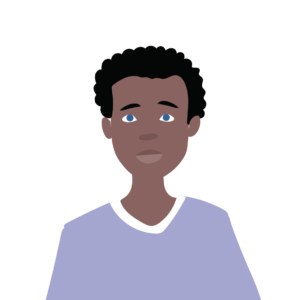What is Albinism ?
Albinism is a genetic condition caused by mutations of certain genes that affect the amount of melanin that one’s body produces. For people living with albinism, their bodies are unable to make a normal amount of melanin, the substance that is responsible for eye, skin, and hair color. So most people with albinism have very pale skin, hair, and eyes.
Albinism is a genetic condition that people are born with. It is not a disease, it is neither contagious nor can it be spread.
People with Albinism often have to protect themselves against sunlight and are prone to skin conditions such as skin cancer. They also often have low vision and will need glasses for reading in combination with large print.

How to refer to someone with Albinism
The word “albino” comes from the Latin word “albus,” meaning white. While people with albinism are sometimes called albinos, this can be taken as derogatory. It is preferred to say a “person with albinism”.
Different types of albinism
Oculocutaneous albinism (OCA): This is the most common type of albinism. People with OCA have extremely pale hair, skin and eyes. There are seven different subtypes of OCA, caused by mutations in one of seven genes (OCA1 to OCA7).

Hermansky-Pudlak syndrome (HPS): Hermansky-Pudlak syndrome is a type of albinism that includes a form of oculocutaneous albinism that includes a range of blood disorders, bruising conditions and lung, kidney or bowel diseases.
Ocular albinism (OA): Ocular albinism is not as common as OCA. Ocular albinism affects only one’s eyes – usually presenting as blue eyes though in some cases may appear pale, red or pink. Skin and hair color are usually normal.

Chediak-Higashi syndrome: Chediak-Higashi syndrome is a type of albinism that includes a form of oculocutaneous albinism along with immune and neurological conditions.
Myths around albinism
There are a lot of myths about people with Albinism in some communities:
Myth about People with albinism
- The are a source of wealth
- Having sex with a person with Albinism will cure HIV
- Their life span is very long
- They have spiritual powers
- Albinism is contagious
- Their life span is very long
- They don’t die, but they disappear
- Using whitening cream can cause Albinism
Truth
- This is NOT true
- This is NOT true
- This is not true, people with Albinism have an average life span, but they have a higher risk of getting skin cancer.
- This is not true. They have the same powers as any other human being
- This is not true: Albinism is a genetic condition. People with Albinism can have children without Albinism. And the other way around.
- This is not true, people with Albinism have an average life span, but they have a higher risk of getting skin cancer.
- This is not true
- This is not true. It is a genetic condition.
Creating an enabling environment for people with Albinism
- Raise awareness about Albinism and address the myths surrounding the condition
- People with Albinism may have low vision, so they may need large print. Some may prefer using assistive technology like a magnifying glass or screen-reader software and have soft copies of print materials (if possible or relevent).
- People with Albinism may need a specific sitting arrangement for a training (under a tree, close to the front)
- Measures need to be taken to protect people with Albinism from sunlight: e.g. shade if working outside, clothes and hats to cover their bodies in combination with sunscreen
